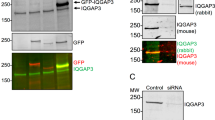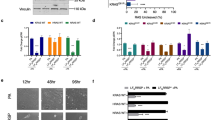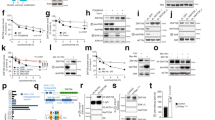Abstract
AGS1/RASD1 is a Ras-related protein identified as a dexamethasone-inducible cDNA and as a signal regulator in various functional and protein-interaction screens. As an initial approach to define the role of AGS1/RASD1 as a Ras-family member, we determined its influence on cell growth/survival. In clonogenic assays with NIH-3T3 murine fibroblast cells, the MCF-7 human breast cancer cell line and the human lung adenocarcinoma cell line A549, AGS1/RASD1 markedly diminished the number of G418-resistant colonies, whereas the Ras subgroup member K-Ras was without effect. A549 cell infection with adenovirus engineered to express AGS1/RASD1 (Ad.AGS1) inhibited log phase growth in vitro and increased the percentage of cells undergoing apoptosis. The anti-growth action was also observed in vivo as the expression of AGS1/RASD1 inhibited the subcutaneous tumor growth of A549 cells in athymic nude mice. These data indicate that AGS1/RASD1, a member of the Ras superfamily of small G-proteins that often promotes cell growth and tumor expansion, plays an active role in preventing aberrant cell growth.
This is a preview of subscription content, access via your institution
Access options
Subscribe to this journal
Receive 50 print issues and online access
$259.00 per year
only $5.18 per issue
Buy this article
- Purchase on Springer Link
- Instant access to full article PDF
Prices may be subject to local taxes which are calculated during checkout




Similar content being viewed by others
References
Cismowski MJ, Ma C, Ribas C, Xie X, Spruyt M, Lizano JS, Lanier SM and Duzic E . (2000). J. Biol. Chem., 275, 23421–23424.
Cismowski MJ, Takesono A, Ma C, Lizano JS, Xie X, Fuernkranz H, Lanier SM and Duzic E . (1999). Nat. Biotechnol., 17, 878–883.
Der CJ . (1989). Cancer Treat. Res., 47, 73–119.
Ellis CA, Vos MD, Howell H, Vallecorsa T, Fults DW and Clark GJ . (2002). Proc. Natl. Acad. Sci. USA, 99, 9876–9881.
Fang M, Jaffrey SR, Sawa A, Ye K, Luo X and Snyder SH . (2000). Neuron, 28, 183–193.
Finlin BS, Gau CL, Murphy GA, Shao H, Kimel T, Seitz RS, Chiu YF, Botstein D, Brown PO, Der CJ, Tamanoi F, Andres DA and Perou CM . (2001). J. Biol. Chem., 276, 42259–42267.
Foster R, Hu KQ, Lu Y, Nolan KM, Thissen J and Settleman J . (1996). Mol. Cell. Biol., 16, 2689–2699.
Graham TE, Key TA, Kilpatrick K and Dorin RI . (2001). Endocrinology, 142, 2631–2640.
Graham TE, Prossnitz ER and Dorin RI . (2002). J. Biol. Chem., 277, 10876–10882.
Gudermann T, Grosse R and Schultz G . (2000). Naunyn-Schmiedebergs Arch. Pharmacol., 361, 345–362.
Gutkind JS . (1998). Oncogene, 17, 1331–1342.
Jaffrey SR, Fang M and Snyder SH . (2002). Chem. Biol., 9, 1329–1335.
Kemppainen RJ and Behrend EN . (1998). J. Biol. Chem., 273, 3129–3131.
Kemppainen RJ, Cox E, Behrend EN, Brogan MD and Ammons JM . (2003). Biochim. Biophys. Acta, 1627, 85–89.
Koga T, Iwasaki H, Ishiguro M, Matsuzaki A and Kikuchi M . (2002). Cancer Genet. Cytogenet., 136, 113–120.
Lanier SM, Downing S, Duzic E and Homcy CJ . (1991). J. Biol. Chem., 266, 10470–10478.
Lanson Jr NA, Friedlander PL, Schwarzenberger P, Kolls JK and Wang G . (2003). Cancer Res., 63, 7936–7941.
Luo RZ, Fang X, Marquez R, Liu SY, Mills GB, Liao WS, Yu Y and Bast RC . (2003). Oncogene, 22, 2897–2909.
Soenen V, Preudhomme C, Roumier C, Daudignon A, Lai JL and Fenaux P . (1998). Blood, 91, 1008–1015.
Stacey MW, Wang J, Byrd RL, Liu JM and Kearns WG . (1999). Genes Chromosomes Cancer, 25, 191–193.
Takai Y, Sasaki T and Matozaki T . (2001). Physiol. Rev., 81, 153–208.
Takesono A, Cismowski MJ, Ribas C, Bernard M, Chung P, Hazard III S, Duzic E and Lanier SM . (1999). J. Biol. Chem., 274, 33202–33205.
Takesono A, Nowak MW, Cismowski M, Duzic E and Lanier SM . (2002). J. Biol. Chem., 277, 13827–13830.
Tu Y and Wu C . (1999). Biochim. Biophys. Acta, 1489, 452–456.
Vargiu P, De Abajo R, Garcia-Ranea JA, Valencia A, Santisteban P, Crespo P and Bernal J . (2004). Oncogene, 23, 559–568.
Acknowledgements
This work was supported by awards (MH90531 (SML) and NS24821 (SML)) from the National Institutes of Health. SML is greatly appreciative of the support provided by a Research Scholar Award from Yamanouchi Pharmaceutical Company, Inc. and the David R Bethune/Lederle Laboratories Professorship in Pharmacology. SML and GV appreciate the technical assistance provided by Maureen Fallon and Dallis Green, as well as the efforts of the LSUHSC cell culture core manager Joelle Finley, the LSUHSC vector core manager Robert Kutner and Nick Lanson (Gene Therapy/Medicine, LSUHSC). We also thank Aaron Adamson (Department of Biochemistry, LSUHSC) and Constance Porretta (Gene Therapy/Medicine, LSUHSC) for assistance in FACS analysis. Dr Catalina Ribas was involved in the isolation of rat AGS1/RASD1 from a rat brain cDNA library. We also appreciate the comments, support and reagents provided by Drs Emir Duzic (Millennium Pharmaceuticals Inc, Cambridge, MA), SM Hill (Tulane Cancer Center, New Orleans, LA), Andrew D Catling, Hamid Boulares, Joe B Blumer and Frank Park (Department of Pharmacology, LSUHSC).
Author information
Authors and Affiliations
Corresponding author
Rights and permissions
About this article
Cite this article
Vaidyanathan, G., Cismowski, M., Wang, G. et al. The Ras-related protein AGS1/RASD1 suppresses cell growth. Oncogene 23, 5858–5863 (2004). https://doi.org/10.1038/sj.onc.1207774
Received:
Revised:
Accepted:
Published:
Issue Date:
DOI: https://doi.org/10.1038/sj.onc.1207774
Keywords
This article is cited by
-
RNA-Seq analysis in giant pandas reveals the differential expression of multiple genes involved in cataract formation
BMC Genomic Data (2021)
-
Nuclear transporter Importin-13 plays a key role in the oxidative stress transcriptional response
Nature Communications (2021)
-
Long intergenic non-protein-coding RNA 01446 facilitates the proliferation and metastasis of gastric cancer cells through interacting with the histone lysine-specific demethylase LSD1
Cell Death & Disease (2020)
-
Dexras1 is a homeostatic regulator of exercise-dependent proliferation and cell survival in the hippocampal neurogenic niche
Scientific Reports (2018)
-
Overexpression of RASD1 inhibits glioma cell migration/invasion and inactivates the AKT/mTOR signaling pathway
Scientific Reports (2017)



